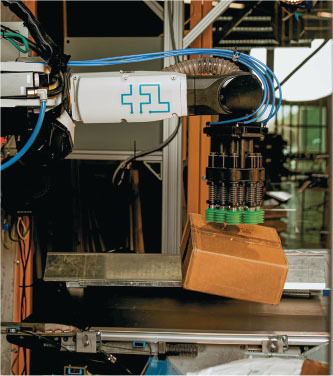Product Spotlight
 It is a modern mantra: “Technology will never be as bad as it is today.” In other words, as transformative as automation, artificial intelligence (AI) and other technologies already are to supply chain matters, they can only get faster, smarter, more efficient and more cost-effective from here.
It is a modern mantra: “Technology will never be as bad as it is today.” In other words, as transformative as automation, artificial intelligence (AI) and other technologies already are to supply chain matters, they can only get faster, smarter, more efficient and more cost-effective from here.
“In terms of speed of processing in the area of logistics, I’ve placed orders with the ‘big A’ that have arrived at my house the same day,” said Dean Elkins, senior director of advanced automation with automation and process integration company MHI member Gray Solutions and The Robotics Group (TRG) co-vice chair. “Aside from the luck that your ordered items are at the closest warehouse, all the rest of it is software-driven and automation-driven. Orders that I used to place and needed to wait a week or more for are now happening in two days or less.”
Cohesive tools
“The industry started with little islands of automation,” said Crystal Parrott, COO of MHI member Plus One Robotics—a parcel-handling robotics company—and the chair of MHI’s TRG. “Everyone was selling a piece of the equipment flow. ‘I have a pick place, I have autonomous mobile robots (AMR), I’ve got a drone.’ Now what I see it evolving to is the ability to use a variety of those for an entirely new warehouse process flow.”
From a data standpoint, there are still islands. “You have the Internet of Things (IoT), artificial intelligence as it relates to routing and actual process flows within the warehouse operation as well as the last-mile configurations,” said Parrott. “That’s industry-wide for not only robotics but for all the conveyance, the new mobile platforms, the new drone platforms. How much of that data has bubbled up to inform good operational decisions within an entire facility?
“What’s going to happen is the merging of all this data with cloud computing, enabling the crunching of the data, to then do AI and planning around different routing or better delivery or weight modifications based on what is being discovered from metrics from certain routes.” That said, Parrott also states the real paradigm shift will be not how much data is aggregated and used—from input to delivery—but what data is most useful, separating what’s unnecessary to optimize the workflow.
Sensory tools and automation
If you go back in the not-too-distant past when present levels of flexible automation were being implemented—whether it be in warehouses, distribution, food and beverage factories, or the many other disciplines working with automation—people were doing slightly slower, less complex applications with robots like moving product from a conveyor to palletizing.
Technology evolved with the introduction of sensory tools and vision systems that allowed for applications like high-speed picking to take place. “Now you were palletizing product and, at the front of the line, you were doing highspeed packaging applications,” Elkins noted. “As these sensory tools evolved, the levels of automation increased, but the deployment of that same automation has become far more simplified. You don’t need to go out to create massive amounts of robot code for that same palletizing protocol as you would have 10 years earlier.”
Today, with a collaborative robot, according to Elkins, you can handguide a machine through its programming path and teach it in a very simple way rather than having to do it with a device in your hands like a tablet.
Parrott added, “Robotic piecepicking is one of the things identified as reducing a big bulk of labor within warehouse operation. Additionally, AI is growing very sophisticated in terms of the identification of the product.”
Through repeated processes and collected metrics, machine learning can go beyond the rudiments. Artificial intelligence lets a robot learn a picking sequence or a gripper position based on past successes and failures to enable higher instances of success in handling that product.
PHOTO PROVIDED BY PLUS ONE ROBOTICS
 MHI Solutions Improving Supply Chain Performance
MHI Solutions Improving Supply Chain Performance